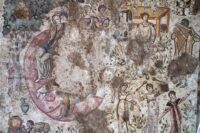 A mosaic depicting an outdoor feast has been discovered in the ruins of a 6th century villa at the ancient Roman site of Germanicia Caesarea, modern-day Kahramanmaraş, in southeastern Turkey. The ancient rager features three
A mosaic depicting an outdoor feast has been discovered in the ruins of a 6th century villa at the ancient Roman site of Germanicia Caesarea, modern-day Kahramanmaraş, in southeastern Turkey. The ancient rager features three 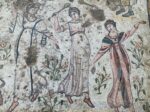 women dancing and playing on crotala (ancient Greek castanets) accompanied by a musician on a large pan flute, two couples snuggling as they watch the festivities, two men in front of a table with plates and vessels, one man on all fours who is either painting a krater on a tripod or drinking
women dancing and playing on crotala (ancient Greek castanets) accompanied by a musician on a large pan flute, two couples snuggling as they watch the festivities, two men in front of a table with plates and vessels, one man on all fours who is either painting a krater on a tripod or drinking 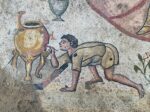 from it with a straw and a young boy climbing a fig tree. A profusion of flowers and trees landscape the scene.
from it with a straw and a young boy climbing a fig tree. A profusion of flowers and trees landscape the scene.
Archaeologists believe the 540-square-foot mosaic is the continuation of a panel depicting hunting scenes that was unearthed in the 2015 excavation of Germanicia. The feast is probably a pre-hunt banquet.
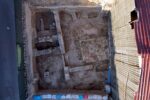 The city was already an important one in the 10th century when it was the capital of the Neo-Hittite state of Gurgum. Under Roman control, it was renamed Germanicia Caesarea, likely after Germanicus Julius Caesar, retriever of the legionary
The city was already an important one in the 10th century when it was the capital of the Neo-Hittite state of Gurgum. Under Roman control, it was renamed Germanicia Caesarea, likely after Germanicus Julius Caesar, retriever of the legionary 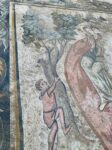 eagles captured after the disastrous Roman defeat in the Battle of Teutoburg Forest, adopted son of the Tiberius and father of Caligula. Germanicia prospered well into Late Antiquity, as the mosaics attest to, and is unusual in that pagan motifs and deities were still prevalent in the mosaics throughout the 6th century.
eagles captured after the disastrous Roman defeat in the Battle of Teutoburg Forest, adopted son of the Tiberius and father of Caligula. Germanicia prospered well into Late Antiquity, as the mosaics attest to, and is unusual in that pagan motifs and deities were still prevalent in the mosaics throughout the 6th century.
The city was heavily damaged during the Arab-Byzantine Wars of the 7th century and eventually ancient Germanicia’s location was lost. It was 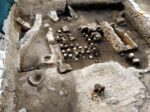 rediscovered only in 2007 when illegal excavations under a private home revealed Roman-era mosaics. Authorities were tipped off to the find and archaeologists excavated the area, discovering a motherlode of about 20 high-quality mosaics that decorated the floors of elite Roman villas.
rediscovered only in 2007 when illegal excavations under a private home revealed Roman-era mosaics. Authorities were tipped off to the find and archaeologists excavated the area, discovering a motherlode of about 20 high-quality mosaics that decorated the floors of elite Roman villas.
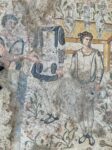 Since then, excavations have revealed about 100 villas in the area, each of them with numerous rooms. The mosaics adorned the ground floor rooms. They all date to between the 4th and 6th centuries A.D. and are exquisitely crafted out of prized materials like colored glass and marbles. The artists used the diversity of the tesserae to remarkable effect, creating scenes that are almost 3D in parts. See for example the table in the center of the party mosaic with the glassware vessels that appear
Since then, excavations have revealed about 100 villas in the area, each of them with numerous rooms. The mosaics adorned the ground floor rooms. They all date to between the 4th and 6th centuries A.D. and are exquisitely crafted out of prized materials like colored glass and marbles. The artists used the diversity of the tesserae to remarkable effect, creating scenes that are almost 3D in parts. See for example the table in the center of the party mosaic with the glassware vessels that appear 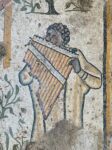 almost translucent.
almost translucent.
Digs will pick up again this year and archaeologists hope to fully excavate the remains of the villa with the party mosaic. The tentative plan is to open the site to the public at the end of the year as an archaeological park with walkways installed to keep the delicate floors free from grinding hobnails.